|
The Japanese attack
on Pearl Harbor in December 1941, suddenly and without warning, put
our nation at war for the second time in just over two decades. Only
this time it really was a world war. Fighting spread to the far
reaches of the globe and included multiple theatres of operation. No
area proved more challenging for the US Army Quartermaster Corps than
the war in the Pacific.
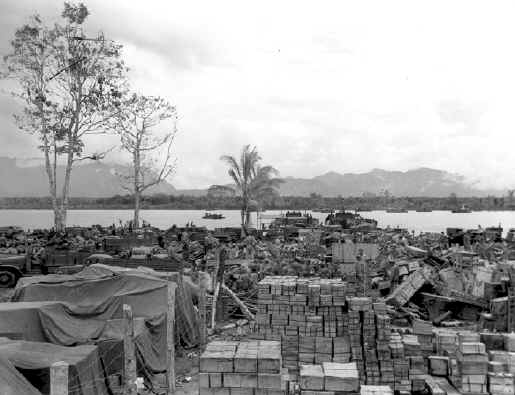
General Douglas
MacArthur said afterwards that the magnitude of the Corps’
assignment in the Pacific Theatre and its performance in carrying out
the supply mission was "without parallel in the history of
warfare." Quartermasters had to generate unheard of levels of
supply and maintain a steady flow of goods across thousands of miles
of ocean. Also, Quartermasters had to support varied actions on widely
separated islands, in what can only be described as a "new kind
of war" – all the while overcoming hurdles never before
encountered.
Quartermasters
provided Class I, II, III and IV items (food, clothing and equipment,
petroleum and general supplies) to Allied troops throughout the
region. Frequent shortages of supplies and chronic delays added to the
soldiers’ discomfort. Yet, such lapses never seriously undermined
troop morale or fighting capacity. Quartermasters, in short, did what
they set out to do. They made victory possible.
But how? How did
they make victory possible? What did the process of World War II
supply entail? What obstacles lay in the path, and how were they dealt
with? As we continue to think about the future of Army logistics in
the 21st Century and about the role of Quartermasters in the decades
ahead, it is still useful to probe the past for historical insights
and analogies. The war in the Pacific offers an example of "force
projection" on a grand scale.
Factory to Foxhole
Getting much-needed Quartermaster items from factories and farms in
the continental United States into the hands of user units and combat
soldiers abroad was no mean task. This involved a series of
complicated steps and inter-related functions.
|
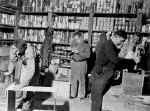
|
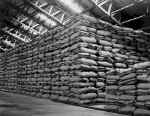
|
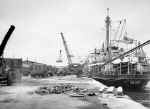
|
| Procurement |
Storage |
Distribution |
The
first step was procurement. Effective procurement entailed more than
simply calculating user needs and filling out the right requisitions.
The nation’s wartime industrial, manufacturing and agricultural
capacity had to be brought up to speed. There had to be masses of
trained personnel with purchasing, inspection and supply management
skills; coupled with effective administrative procedures and inventory
control techniques. All this and more had to be well established for
requisitions to have any chance of being filled.
Next,
Quartermasters had to deal with issues relating to proper storage.
Almost all items required at least some care in packaging and handling
and also protection from the elements while awaiting shipment to a
distant location. Indeed, perishable foods such as fresh meat,
vegetables and dairy products required even more protection, as well
as sensitive handling and specialized equipment for proper storage.
Supply personnel heading into a theatre of operations always hoped for
good docking facilities, buildings suitable for warehouses, materials
handling equipment, and adequate storage containers to protect
incoming goods. Without these, Quartermasters knew their job would be
infinitely more difficult and the instances of loss, wastage,
pilferage and so on, far greater.
Alas,
the Quartermaster’s final responsibility was to oversee the proper
distribution of goods. To make sure the right items got from base and
storage areas to the user units in the field, in the amounts needed
and in a timely fashion. Success here depended on many variables,
including the type and size of units to be supplied. How far forward
they were from the base area or resupply checkpoint. Weather and
terrain in the area. Road conditions and transportation available. The
commander‘s priorities, and, of course, the tactical situation.
What
made the supply process difficult in World War II was the rapid
expansion of the armed forces and the hurry-up nature of logistics in
the months following Pearl Harbor. Years of neglect had to be overcome
as quickly as possible. Yet all that took time. Time for the
nation’s industrial base to reach its full potential. Time for a
newly mobilized Quartermaster Corps to obtain the necessary manpower
and training, the specialized units and equipment, the organization
and doctrine, and other institutions needed to carry out its global
mission.
Against
this backdrop loomed another set of factors that made Quartermaster
operations in the Pacific uniquely onerous:
"Europe
First" Strategy.
The
decision by Allied war planners to take on Hitler first had a major
impact on Quartermaster operations in the Pacific. They felt the pinch
of scarcity often as the mass of supplies and transportation were
diverted to Europe. During the immense build-up preceding the Normandy
Invasion, Quartermasters in the Pacific had to contend with long
delays, huge backlogs of unfilled requisitions, and a worrisome
depletion of available stocks on hand. The situation did not permit
dramatic improvements until the last year of the war, most notably
after V-E Day (Victory in Europe Day, May 8, 1945).
Long
Supply Lines. The huge size of the Pacific Theatre, which had to be
subdivided into three separate spheres – the South Pacific, Central
Pacific and Southwest Pacific commands, respectively – made for
unprecedented long lines of communication. Roughly 3,000 miles
separated the New York port of embarkation, the Quartermaster Corps’
main shipping centre on the East Coast, from England and France. Yet
more than twice that amount of ocean (6,200 miles) lay between San
Francisco on the West Coast, and Brisbane, Australia, where most
Quartermaster supplies in the Southwest Pacific were sent and
received. Instead of the usual 55 to 60 days for a supply ship to go
from New York to Liverpool, the trip from San Francisco to Brisbane
often lasted four or five months – nearly two to three times longer.
When items had to be moved from point to point within theatre, the
journey could be extended to upwards of 8,000 miles.
The huge size of the Pacific Theatre,
which had to be subdivided into three separate spheres – the South
Pacific, Central Pacific and Southwest Pacific commands, respectively
– made for unprecedented long lines of communication. Roughly 3,000
miles separated the New York port of embarkation, the Quartermaster
Corps’ main shipping centre on the East Coast, from England and
France. Yet more than twice that amount of ocean (6,200 miles) lay
between San Francisco on the West Coast, and Brisbane, Australia,
where most Quartermaster supplies in the Southwest Pacific were sent
and received. Instead of the usual 55 to 60 days for a supply ship to
go from New York to Liverpool, the trip from San Francisco to Brisbane
often lasted four or five months – nearly two to three times longer.
When items had to be moved from point to point within theatre, the
journey could be extended to upwards of 8,000 miles.
Such
long lines of communication placed a heavy premium on reliable
shipping. Also, a persistent worldwide shipping shortage that lasted
for much of the war meant that Quartermasters had to compete for
precious cargo space with other service branches. Shipping delays also
led to more deterioration and mass spoilage. At the same time, long
supply lines increased the chances of accidents and enemy
interdiction.
Underdeveloped
Countries. Very few areas outside of Hawaii, Australia and New Zealand
offered anything in the way of modern industrial facilities or a
usable infrastructure (such as highways, railroads, depots, warehouses
and improved communication) that might have eased the burden of
Quartermaster storage and distribution in the Pacific Theatre. Many of
the bases from which they initially operated had few if any man-made
facilities. Construction often began with the simple materials at hand
and never approached the hoped-for levels of efficiency. This virtual
absence of industrial resources and improved networks and facilities
increased the number of losses and added more delays in the supply
system
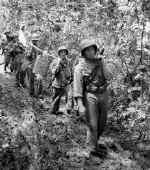 Harsh
Weather and Terrain. Perhaps
more than anything else, environmental factors worked against
Quartermaster efforts in the Pacific. Excessive heat and humidity, mould
and mildew, long exposure to tropical sunlight, drenching rain storms
and the ravages of insects all had a debilitating influence on
supplies. Harsh
Weather and Terrain. Perhaps
more than anything else, environmental factors worked against
Quartermaster efforts in the Pacific. Excessive heat and humidity, mould
and mildew, long exposure to tropical sunlight, drenching rain storms
and the ravages of insects all had a debilitating influence on
supplies.
Food
and rations spoiled when left unconsumed for too long. Wooden and
cardboard packages quickly deteriorated, labels wore off and cans
rusted, leaving their contents useless. Shoes and clothing wore out at
a much faster pace in the Pacific, even as their replacements often
rotted in storage. Salt spray and sharp-edged coral took an equally
heavy toll on packaged goods, vehicles and equipment moving over
beaches. Muddy ports, washed-out roads and bridges, high mountains and
dense jungles all severely hampered interior distribution. The
environment posed a constant and unremitting challenge.
"Island-Hopping"
Tactics. As General
MacArthur’s successful "island-hopping" campaign unfolded,
Quartermasters in the Pacific had to become increasingly adept at
joint operations (working under Navy guidelines) while learning to
perfect the demanding procedures required to support amphibious,
over-the-shore types of supply operations. The new tactics called for
rapid logistical planning, tailored inventories, and quick development
and movement of bases – in short, it meant functioning in a very
unsettled environment where routine supply procedures had to make way
for far greater flexibility.
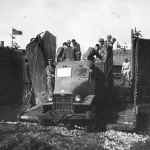 Anticipation
is key to good logistics. Yet, at times, Quartermasters had little
advanced warning of what was to come next, hence almost no time to
prepare. The 7th Quartermaster Company, for example, underwent several
weeks of intense planning and preparation in late summer 1944 getting
ready for the projected Yap campaign. The company did not learn until
mid-September – after the division was already at sea! – that the
plan had been radically altered. Instead of attacking the small island
of Yap, they found themselves heading hundreds of miles west to a much
larger and more heavily defended Leyte. Anticipation
is key to good logistics. Yet, at times, Quartermasters had little
advanced warning of what was to come next, hence almost no time to
prepare. The 7th Quartermaster Company, for example, underwent several
weeks of intense planning and preparation in late summer 1944 getting
ready for the projected Yap campaign. The company did not learn until
mid-September – after the division was already at sea! – that the
plan had been radically altered. Instead of attacking the small island
of Yap, they found themselves heading hundreds of miles west to a much
larger and more heavily defended Leyte.
Most
Quartermaster supply operations issued forth from depots established
at a series of far-flung ports and bases throughout the theatre. With
each new amphibious assault across primitive terrain, another round of
forward area bases and sub-bases had to be constructed. From these,
more supplies were massed and pushed forward.
This
set of procedures stood in marked contrast to Europe. There, the task
mainly entailed opening a single line across the English Channel and
falling in on a pre-existing infrastructure, while continuing to
improve and expand operations. One observer likened the European
operation to "a single hose growing larger in diameter as the
immensity of operations increased." Pacific supply, on the other
hand, with its widely scattered bases, was "like a lawn sprayer
with a new stream of supply for every new supply operation."
Rations
and Subsistence (Class I)
An unbroken, steady supply of food and rations, of course, is vitally
important to the survival of any army. The Allies got a reminder of
this in the opening days of the war. Filipino and US troops trapped on
Bataan peninsula after Pearl Harbor saw a complete breakdown in food
supply. By the time they were forced to surrender in April 1942, all
subsistence had been exhausted. Those captured were suffering from
widespread disease and malnutrition. It was a lesson not to be
forgotten.
In
the months and years that followed, Quartermaster food personnel in
the Pacific saw their efforts hampered in varying degrees by all the
major factors previously discussed – problems associated with
procurement, long lines of communication, inadequate storage,
transportation shortages, and all the rest.
Loss
of Food. For much of the war the Pacific Theatre experienced
persistent heavy losses of food, resulting in unbalanced stocks in
certain areas, chronic shortages elsewhere, and routine cycles of
"feast-and-famine" among some unit messes. The problem of
food loss – which some observers claimed ran as high as 40 percent
at times – stemmed from a number of sources:
For much of the war the Pacific Theatre
experienced persistent heavy losses of food, resulting in unbalanced
stocks in certain areas, chronic shortages elsewhere, and routine
cycles of "feast-and-famine" among some unit messes. The
problem of food loss – which some observers claimed ran as high as
40 percent at times – stemmed from a number of sources:
Storage
Problem. With limited
warehousing available in most areas outside of Australia and New
Zealand, Class I items shipped to the Pacific often had to be stacked
in big open food dumps, with very little if any protection from the
elements. Even canned foods, supposedly "non-perishable,"
suffered from high temperatures, corrosion, rusting and puncturing due
to rough handling. In New Caledonia, for instance, in late 1943, one
observer reported seeing what amounted to "shiploads" of
goods totally wasted, useless; and "over 100,000 cans of spoiled
products" in a single dump.
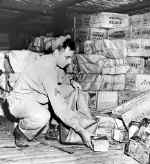 Quartermasters
tried to mitigate such losses through adoption of various field
expedients. Tarpaulins and poles were often used to create
"portable warehouses" and "paulin oases," as they
were called. They also used local materials such as and constructed
thatched roof warehouses modelled upon native huts known as
"bures." Quartermasters
tried to mitigate such losses through adoption of various field
expedients. Tarpaulins and poles were often used to create
"portable warehouses" and "paulin oases," as they
were called. They also used local materials such as and constructed
thatched roof warehouses modelled upon native huts known as
"bures."
Packaging
Problems. Rough handling of food supplies – carelessly sling loaded
and dumped in huge cargo holds, for example, or unceremoniously
dropped on beaches during amphibious assaults, or pushed off the back
end of trucks – also caused tremendous losses.
Rough handling of food supplies
– carelessly sling loaded and dumped in huge cargo holds, for
example, or unceremoniously dropped on beaches during amphibious
assaults, or pushed off the back end of trucks – also caused
tremendous losses.
Back
in the United States, the Office of the Quartermaster General’s
research and development (R&D) agency (the Military Planning
Division) worked closely with private manufacturers to come up with
more resilient and durable outer packaging. The new V-Boxes, as they
were called, did not stack as well as wooden boxes and were not
totally moisture proof. The V-boxes did prove relatively durable, were
easier to handle and saved space. Quartermaster R&D specialists
also produced sturdy moisture- and insect-resistant paper sacks for
all kinds of food packaging, and improved tin can markings for when
labels tore off. Together these innovations helped alleviate food
losses in-theatre.
Distribution
Problems. The problem of getting
food and rations into the hands of front line troops was always
difficult. The theatre lacked the necessary land-based and sea-based
refrigerators to ensure a steady supply of fresh meats, produce and
dairy products. Primitive roads rarely permitted the use of
semitrailers or refrigerator vans, even had those been available. On
occasion, enemy actions dealt a heavy blow to food distribution
efforts.
During the Hollandia campaign in
April 1944, for example, on the second day after the Allied landing, a
Japanese plane scored a direct hit on the ammunition dump at White
Beach 1. Subsequent explosions ignited gasoline stores in the area
that, in turn, spread to the main Class I dump nearby. The disaster
wound up destroying more than 400,000 rations – a full 60 percent of
the inventory. Advancing Infantry soldiers had to go immediately on
half rations. Initial attempts to airdrop emergency food supplies also
failed, and stocks on hand soon dwindled to a mere 300 cases.
Fortunately, some soldiers managed to sustain themselves mainly on
captured Japanese rice and canned fish.
Amphibious
operations and fighting along narrow strips of beach, or continuous
movement through dense jungles and over steep mountain ranges
discouraged the use of A-Rations (fresh foods) or B-Rations (canned
stores) - both of which had to be prepared by a trained cook. In such
circumstances, mobile kitchens could not have kept up, and roads would
not have allowed even quarter-ton trucks loaded with Marmite cans to
reach everyone. Harsh weather and terrain often precluded even
carrying hot food by hand or using pack animals. The only solution was
to provide combat troops with sufficient amounts of individual
rations, which they could carry and prepare themselves.
Quartermaster
R&D food specialists laboured to meet the specialized needs and
unique requirements of troops fighting in the Pacific. They came up
with much improved C-Rations; lightweight "jungle rations"
and K-Rations (both of which troops regarded as "picnic
lunches"); high-energy, chocolate bars called D-Rations (for
emergency uses only); and Assault Rations (often referred to as
"candy rations") tailor-made for amphibious warfare. These
helped ease the storage and distribution burden, while providing
commanders with increased flexibility.
Clothing,
Equipment and General Supplies (Classes II and IV)
Quartermasters in the Pacific, for a variety of reasons, habitually
had trouble getting sufficient reserves of clothing and equipment.
Part of it had to do with the pace of mobilization. It took time for
the US clothing and textile industry to obtain the necessary raw goods
from among sometimes-scarce commodities. Also, for a diverse army such
as ours, thousands of uniform specifications and new tariff sizes
needed to be drawn up, and sometimes manufacturing plants had to be
completely retooled for full-scale production. This also had to be
balanced against the needs of troops destined for Europe.
Class II and IV
supplies usually did not enjoy high-priority status for overseas
shipping. Among commanders, delays in receipt of clothing and
equipment did not seem to arouse the same level of anxiety as that
caused by almost any perceived shortage in food or petroleum products.
The latter were deemed bona fide "war stoppers" and took
first priority. As a result, Quartermasters in the Pacific often found
that their requisitions for clothing, footwear, cots, tents, mess
equipment and the like, in effect, had been placed on the back burner.
When initial issue stocks wore out, it sometimes took exceeding long
for replacement goods to arrive. On such occasions, troops necessarily
bore a certain amount of hardship and discomfort.
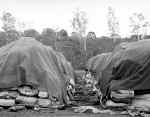 Packing
and Storage Problems. As with
Class I food supplies, clothing and equipment incurred considerable
losses due to packing for overseas shipment and from want of adequate
warehouses and other storage facilities after arrival in-theatre. It
was generally easier to pack clothing and equipment than food.
Shippers relied on a variety of methods, including wooden boxes and
crates, plywood cases, wood-cleated fibreboard containers, and V-Boxes
for smaller items. Packing
and Storage Problems. As with
Class I food supplies, clothing and equipment incurred considerable
losses due to packing for overseas shipment and from want of adequate
warehouses and other storage facilities after arrival in-theatre. It
was generally easier to pack clothing and equipment than food.
Shippers relied on a variety of methods, including wooden boxes and
crates, plywood cases, wood-cleated fibreboard containers, and V-Boxes
for smaller items.
The typical
procedure was to pack clothing and fabric products in tightly drawn up
and covered "bales" for easy handling at ports and depots.
Sometimes the waterproof covering tore off, allowing dampness to seep
in and mildewing to occur. Occasionally, rusted metal straps broke,
causing the contents to become scattered and exposed. By and large,
baling proved an effective means of packing.
Less certain was
what happened to clothing and equipment after it arrived in-theatre
and went into base storage areas. The environmental effects could be
devastating. Cotton clothing or towels, for instance, left in
unventilated stockpiles, with nothing but a piece of tarpaulin for
cover, quickly became mouldy and took on an unpleasant odour. Wet woollen
blankets soon rotted, and the rusted metal eyelets on shoes fostered
the decomposition of leather. Hard use of clothing, infrequent
laundering and careless handling (such as leaving clothes lying about
in piles) also had extremely debilitating effects.
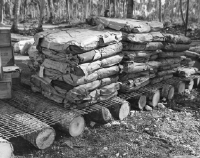 Tentage
and canvas material seemed to suffer the worst. In the course of heavy
campaigning, combat divisions sometimes found that virtually their
entire allotment of tents had become damaged or completely
deteriorated in relatively short order. In fact, there was a chronic
shortage of tents throughout the war. Moisture-saturated stocks got mouldy
and leaked. Even when they arrived in the field in sufficient
quantities, they often failed to serve the purpose for which they were
intended. A group of Australian observers in mid-1943, for instance,
concluded that almost all the tents in New Guinea leaked. Field
Quartermasters used various expedients to try to "tropic
proof" canvas goods to reduce mildewing, but had very limited
success. Tentage
and canvas material seemed to suffer the worst. In the course of heavy
campaigning, combat divisions sometimes found that virtually their
entire allotment of tents had become damaged or completely
deteriorated in relatively short order. In fact, there was a chronic
shortage of tents throughout the war. Moisture-saturated stocks got mouldy
and leaked. Even when they arrived in the field in sufficient
quantities, they often failed to serve the purpose for which they were
intended. A group of Australian observers in mid-1943, for instance,
concluded that almost all the tents in New Guinea leaked. Field
Quartermasters used various expedients to try to "tropic
proof" canvas goods to reduce mildewing, but had very limited
success.
Back home,
Quartermaster R&D specialists worked with scientists and
industrial technicians to come up with water-resistant and
mildew-resistant fabrics to help cope with the "fungus
issue." During the course of the war, they fielded a whole range
of new fabrics, jungle attire and specialized equipment for use in the
Pacific. They also incorporated new camouflaging colours and patterns
for tropical use. They introduced a "tennis shoe" style of
jungle boot in place of service shoes that had a tendency to wear out
in the wet jungles of New Guinea in as little as 10 days. Plus, there
were jungle hammocks, mosquito bars, head nets and protective gloves,
and water-resistant jungle packs. A new 18-inch, broad-blade machete
replaced the old bolo knife for cutting through dense, tangled
vegetation.
The one item that proved the most
useful and popular among combat troops was a rectangular,
blanket-like, rubberised poncho. It was issued early in the war in
place of a raincoat to all embarking for the South and Southwest
Pacific areas. Soldiers quickly learned, though, that ponchos could be
adapted to a multitude of uses – such as effective ground cover,
foxhole "roof," tarpaulin, shelter half, and any number of
other things. By war’s end, an even lighter-weight nylon poncho had
been developed.
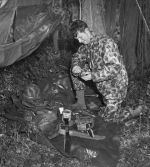 Class
IV Problems. The Quartermaster
Corps garnered a mixed record in the area of general supplies, or
Class IV support, for the Pacific Theatre. This included the vast
assortment of articles that had no prescribed quantity for initial
issue. Such diverse items as rope, soap, candles, knives, forks,
spoons, canned heat, typewriters, field ranges and countless repair
parts – things that rarely, if ever, warranted a "life and
death" priority status. While Allied troops were actively engaged
in combat, Class IV (along with clothing and equipment) usually went
forward on a very restricted basis. In fact, during the New Georgia
campaign in late 1943, the XIV Corps claimed they received no Class IV
supplies whatsoever. Class
IV Problems. The Quartermaster
Corps garnered a mixed record in the area of general supplies, or
Class IV support, for the Pacific Theatre. This included the vast
assortment of articles that had no prescribed quantity for initial
issue. Such diverse items as rope, soap, candles, knives, forks,
spoons, canned heat, typewriters, field ranges and countless repair
parts – things that rarely, if ever, warranted a "life and
death" priority status. While Allied troops were actively engaged
in combat, Class IV (along with clothing and equipment) usually went
forward on a very restricted basis. In fact, during the New Georgia
campaign in late 1943, the XIV Corps claimed they received no Class IV
supplies whatsoever.
Shortages of general
supplies usually stemmed from larger procurement problems: the
inability of manufacturers back in the US to keep pace with
ever-growing wartime demands and the priorities set by unit commanders
– all things that Quartermaster personnel had very little control
over. Still, when the inevitable shortages occurred, Quartermasters
took the heat. The scarcity of Class IV items at the front
unfortunately continued to fuel suspicions that (quote) "Them
bastards in the back areas get all the good stuff."
Petroleum
Products (Class III)
Class III products (or "POL" for petroleum, oils and
lubricants) consisted of various grades of gasoline, kerosene,
aviation fuel, diesel oil, fuel oil and an assortment of
petroleum-based lubricants. POL is absolutely critical for sustainment
of mechanized forces. More vital even than clothing and general
supplies. For without Class III supplies, the engines of war –
planes, ships, tanks, motorized vehicles and all the generators for
electrical use – would cease to operate. Neither fighting units nor
logistical support units could accomplish their varied missions
without POL. As General George S. Patton once said: "My troops
can eat their belts. But my tanks gotta have gas."
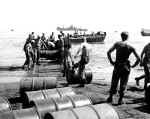 Class
III generally had fewer problems in the Pacific than did other areas
of Quartermaster supply. The high priority accorded POL usually kept
shipping delays to a minimum and helped with efforts to build up
needed reserves. US Quartermasters were also able to draw from private
oil company reserves in Australia and also made full use of that
continent’s excellent bulk storage and handling facilities. Also,
because petroleum is less fragile and does not deteriorate quite so
easily as other materials, it suffered fewer storage hazards. Still
there were problems. Class
III generally had fewer problems in the Pacific than did other areas
of Quartermaster supply. The high priority accorded POL usually kept
shipping delays to a minimum and helped with efforts to build up
needed reserves. US Quartermasters were also able to draw from private
oil company reserves in Australia and also made full use of that
continent’s excellent bulk storage and handling facilities. Also,
because petroleum is less fragile and does not deteriorate quite so
easily as other materials, it suffered fewer storage hazards. Still
there were problems.
Lack of
Bulk Storage and Distribution.
Allied Class III personnel found they could rely on Australian
refineries and excellent bulk storage facilities for support in the
Southwest Pacific until the action moved to New Guinea in 1943.
Thereafter, their assault had to move forward with limited access to
bulk storage facilities. Engineers in New Guinea constructed
medium-sized tanks for a few grades of gasoline and diesel oil created
special dumps and laid aviation fuel pipelines near airports. However,
even these medium- to small-sized temporary storage facilities failed
to meet all needs.
The problem became
more acute in later 1943 and early 1944 as the island-hopping campaign
got into full swing, and a succession of new bases and sub-bases were
built. Larger petroleum vessels had difficulty moving into shallow
waters. When they got in, the vessels often found that hastily built
storage tanks were too small to permit complete unloading of
petroleum. What troops needed, but seldom received, were smaller
vessels capable of hauling fuel between bases and to forward supply
points.
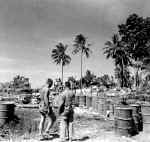 In
the South Pacific area, the Quartermaster Corps had a responsibility
to provide POL to New Zealand ground forces and land-based US Navy and
Marine units, as well as the Army. Quartermasters established massive
POL storage areas on Guadalcanal when that became available, at Green
Island and Espiritu Santo. In
the South Pacific area, the Quartermaster Corps had a responsibility
to provide POL to New Zealand ground forces and land-based US Navy and
Marine units, as well as the Army. Quartermasters established massive
POL storage areas on Guadalcanal when that became available, at Green
Island and Espiritu Santo.
The
Packaged Alternative. The
virtual absence of permanent types of bulk storage facilities and
pipelines throughout the Pacific meant that almost all POL was stored
and distributed in containers – mostly in 55-gallon drums. This
contrasted sharply with experience in Europe. There, Quartermaster
Gasoline Supply Companies received most of their POL from huge fixed
storage facilities, barges or railroad tanker cars and promptly
decanted the POL into 5-gallon jerricans. These were stacked in
warehouses, open dumps, and along roads. POL was moved to user units
in 2½-ton trucks and ¼-ton trailers. In the Pacific, they found the
use of the much smaller jerricans neither practical nor desirable.
The 55-gallon drums
were bulkier, heavier and more difficult to handle. Quartermasters got
around that by using forklifts and winches to load drums onto cargo
trucks. When these were not available, they simply used planks and
manually rolled them onto the trucks. Petroleum Supply Companies also
attached pipes and nozzles right onto the drums and used the drums to
fill vehicles directly. They found that nearly twice the amount of
fuel could be loaded on a standard 2½-ton truck using 55-gallon drums
rather than jerricans.
Despite a persistent
shortage of drums and the absence of modern bulk storage and
distribution facilities, Quartermaster efforts to furnish Class III
supplies to Allied troops in the Pacific can be judged an overall
success.
A Final Assessment
Quartermaster supply operations in the Pacific faced a challenge of
daunting complexity. The task meant, in essence, having to support a
new kind of war in a most difficult environment, on an unprecedented
scale, against a formidable and tenacious foe. What’s more – at a
remarkable distance away from the US.
What were some of
the common elements of success? Certainly local procurement in almost
all areas of supply helped the Quartermaster Corps meets its many
needs, by providing for direct purchase abroad. Major allies in the
region, Australia and New Zealand most notably (along with Hawaii and
many of the South Pacific island nations), made available vast amounts
of goods and material and also furnished much of the labour needed to
carry out such an immense undertaking. Scientific and industrial
support in the form of ongoing research and development projects also
played a key role in addressing some of the age-old logistical
problems encountered in the Pacific.
Still there were
other less tangible, but none the less important, factors
characteristic of Quartermaster success:
Pragmatism Ruled.
Over the course of the Pacific campaign, Quartermaster supply
personnel demonstrated time and again a penchant for practicality –
a "whatever works" approach to problem-solving. A company of
Quartermasters organically attached to a combat division in the
Pacific, for example, routinely undertook tasks never envisioned by
doctrine and organization framers back in the states. Service platoons
maintained much higher than normal stock levels during amphibious
operations, ran stand-alone distribution centres, worked 24-hour
shifts and performed a multitude of unspecified tasks – did whatever
was necessary, and whatever worked.
Likewise, they
applied every conceivable means available to distribute supplies,
including trucks, various-sized landing crafts, DUKWs (amphibious
vehicles), caterpillar tractors, airplanes, pack animals, native labourers,
and hand-carrying of goods. At different times during the Luzon
campaign, for instance, Quartermasters air-dropped supplies to
isolated units; moved food, water, and other materials to front-line
troops via pack train; and hand-carried goods in the steep mountain
ranges above San Jose. Again and again, Quartermasters showed their
tendency to go with whatever worked.
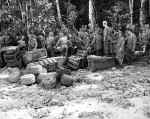 Necessity
the Mother of Invention. Faced
with unusual circumstances and finding that they often lacked even
basic items or equipment for carrying out their mission,
Quartermasters in the Pacific routinely became masters of
improvisation – "QM Imps" – they were sometimes called.
For example, in an effort to speed up movement of supplies over
contested beaches, Quartermasters pioneered the development of
"palletized unit loading." Combat rations, petroleum
products and other supplies were strapped onto rectangular-shaped,
wooden pallets or "sleds," which could be quickly discharged
from landing craft, dragged over beaches, and even moved inland for
great distances to establish instant dumps. At the start of the war,
this efficient technique of cargo handling had barely been known even
among commercial enterprises. Necessity
the Mother of Invention. Faced
with unusual circumstances and finding that they often lacked even
basic items or equipment for carrying out their mission,
Quartermasters in the Pacific routinely became masters of
improvisation – "QM Imps" – they were sometimes called.
For example, in an effort to speed up movement of supplies over
contested beaches, Quartermasters pioneered the development of
"palletized unit loading." Combat rations, petroleum
products and other supplies were strapped onto rectangular-shaped,
wooden pallets or "sleds," which could be quickly discharged
from landing craft, dragged over beaches, and even moved inland for
great distances to establish instant dumps. At the start of the war,
this efficient technique of cargo handling had barely been known even
among commercial enterprises.
Quartermasters also
devised a very effective LST-DUKW system of supply, used for the first
time in the South Pacific by the 7th Infantry Division at Kwajalein.
The landing ships (LSTs) transported the DUKWs (amphibious cargo
carriers) to the assault area soon after the landing. A fleet of LSTs
loaded with mixed cargoes – in what was called "drug
store" fashion – remained just offshore. The Quartermaster
DUKWs, serving as a "motor pool on water," made repeated
runs back and forth in response to commanders’ requests for
resupply.
Lessons
Learned. Finally, the
Quartermaster Corps also demonstrated a remarkable ability to learn
from recent past experience. Throughout the war, the Office of the
Quartermaster General sent observers to gather data on how effective
supply operations were being carried out. They then used this
information to effect needed changes. Lessons learned from previous
assaults were compiled, analysed in detail and applied to the planning
of future operations. The result was more or less steady improvements,
and an accumulated air of proficiency in virtually all areas of
supply.
Quartermasters
learned from after action reports, for example, that most individual
duffel bags and interchangeable pouches (which held all the
soldiers’ personal goods) deteriorated in almost no time when dumped
on beaches without proper storage. Or quickly got lost, or mixed up in
the mayhem. Or were shamelessly pilfered there on the beach, or while
en route to unit dumps, due to lax security. After witnessing this
experience, supply personnel gradually moved away from the use of
individual bags and came up with new methods of storing personal
clothing and equipment in easier to control and protect squad-size
bags. This was only one of many lessons – big and small – learned
by Quartermasters during the war.
Summary.
When the war ended, the Chief Quartermaster in the Southwest Pacific
Area, Brigadier General William F. Campbell, sent a note to all
Quartermasters in his command praising them for their achievements.
Despite the many difficulties, "not once," he asserted,
"did our attack falter because of a lack of Quartermaster
supplies!"
"Never
before in any war," he went on to observe, "have supply
lines been so long. Never before has so much been supplied over such
distances." He concluded his remarks by saying: "I am
confident that logistics experts a few years ago would have said that
the execution of the supply operations you have accomplished in the
last four years [was] impossible. I am equally confident that
historians in the years to come will write of your supply achievements
as one of the miracles of this war."
Looking
back from the perspective of more than a half-century after the war,
General Campbell’s words of praise seem warranted and his assessment
historically valid.
http://www.quartermaster.army.mil
|